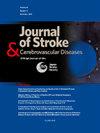院前LVO检测:一种方法不适合所有
IF 1.8
4区 医学
Q3 NEUROSCIENCES
Journal of Stroke & Cerebrovascular Diseases
Pub Date : 2025-04-17
DOI:10.1016/j.jstrokecerebrovasdis.2025.108323
引用次数: 0
摘要
目前正在开发一系列技术,目的是利用生理学数据在院前检测大血管闭塞(LVO)。大多数每种技术的输出都是连续(或有序)变量,但应用阈值来产生简化的二进制结果(即高可能性LVO vs低可能性LVO)。通常选择数学上最优的阈值来平衡敏感性和特异性。虽然直观,但这种方法可能不能适当地解释假阴性和假阳性的相对重要性。最重要的是,依赖单一阈值是一种不必要的过度简化,这种一刀切的院前LVO检测方法并不能最佳地考虑院前护理系统的多样性。在这里,我们使用最近报道的一种技术,光学血流成像,来展示阈值如何容易地滴定,以支持灵敏度或特异性,从而提供可能更好地服务于任何给定微环境的选择。本文章由计算机程序翻译,如有差异,请以英文原文为准。
Pre-hospital LVO detection: One size does not fit all
A range of techniques are being developed with the goal of leverage physiologic data to detect large vessel occlusion (LVO) in the prehospital setting. The output of most every technique is a continuous (or ordinal) variable, but a threshold is applied to yield a simplified binary outcome (i.e., high-likelihood LVO vs low-likelihood LVO). The mathematically optimal threshold is typically selected to balance sensitivity and specificity. Though intuitive, this approach may not appropriately account for the relative significance of false negatives and false positives. Most importantly, relying on a single threshold is an unnecessary oversimplification, and this one-size-fits-all approach to prehospital LVO detection does not optimally account for the diversity of prehospital systems of care. Here, we use a recently reported technique, optical blood flow imaging, to demonstrate how thresholds can be easily titrated in favor of sensitivity or specificity and thereby provide options that may better serve any given micro-environment.
求助全文
通过发布文献求助,成功后即可免费获取论文全文。
去求助
来源期刊

Journal of Stroke & Cerebrovascular Diseases
Medicine-Surgery
CiteScore
5.00
自引率
4.00%
发文量
583
审稿时长
62 days
期刊介绍:
The Journal of Stroke & Cerebrovascular Diseases publishes original papers on basic and clinical science related to the fields of stroke and cerebrovascular diseases. The Journal also features review articles, controversies, methods and technical notes, selected case reports and other original articles of special nature. Its editorial mission is to focus on prevention and repair of cerebrovascular disease. Clinical papers emphasize medical and surgical aspects of stroke, clinical trials and design, epidemiology, stroke care delivery systems and outcomes, imaging sciences and rehabilitation of stroke. The Journal will be of special interest to specialists involved in caring for patients with cerebrovascular disease, including neurologists, neurosurgeons and cardiologists.
 求助内容:
求助内容: 应助结果提醒方式:
应助结果提醒方式:


